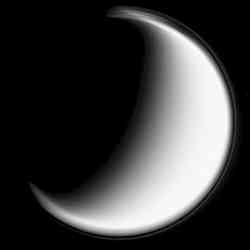
Titan’s multiple hazy layers. Image credit: NASA/JPL/SSI Click to enlarge
This is a composite photograph consisting of 24 photos taken by Cassini of Saturn’s moon Titan. Up at the top of Titan it’s possible to see several layers of clouds in the atmosphere. The top layer is at an altitude of 500 km (300 miles) and probably consists of water ice. Why the atmosphere is separate like this is still a mystery, but scientists think it might have something to do with waves in the atmosphere.
This composite of 24 images from the Cassini spacecraft shows multiple layers in Titan’s stratospheric haze. The most prominent layer is located about 500 kilometers (300 miles) above the surface and is seen at all latitudes, encircling the moon. The material in this layer is probably a condensed substance, possibly water ice.
Several other layers are most apparent in the north polar hood (at top), but this view also shows some at other latitudes. The mechanisms that produce these layers are not understood, but waves in the atmosphere are thought to play a significant role.
The images in this composite were taken over a period of 23 minutes. The images were processed to enhance fine detail and then were combined to create this view. North on Titan (5,150 kilometers, or 3,200 miles across) is up.
The images were taken in visible light with the narrow-angle camera on Jan. 27, 2006 at a distance of approximately 2.3 million kilometers (1.4 million miles) from Titan and at a Sun-Titan-spacecraft, or phase, angle of 155 degrees. Image scale is 13 kilometers (8 miles) per pixel.
The Cassini-Huygens mission is a cooperative project of NASA, the European Space Agency and the Italian Space Agency. The Jet Propulsion Laboratory, a division of the California Institute of Technology in Pasadena, manages the mission for NASA’s Science Mission Directorate, Washington, D.C. The Cassini orbiter and its two onboard cameras were designed, developed and assembled at JPL. The imaging operations center is based at the Space Science Institute in Boulder, Colo.
For more information about the Cassini-Huygens mission visit http://saturn.jpl.nasa.gov . The Cassini imaging team homepage is at http://ciclops.org .
Original Source: NASA/JPL/SSI News Release
